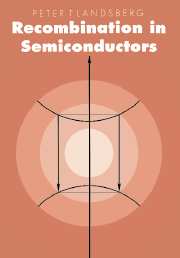Book contents
- Frontmatter
- Contents
- List of main symbols
- Note on units
- Introduction
- 1 Semiconductor statistics
- 2 Recombination statistics
- 3 Auger effects and impact ionization (mainly for bands)
- 4 Radiative recombination (mainly for bands)
- 5 Defects
- 6 Multiphonon recombination
- 7 Recombination in low-dimensional semiconductor structures
- Appendix A The delta function (section 3.2)
- Appendix B Useful identities arising from the periodic boundary condition (section 3.4)
- Appendix C Fourier expansions (section 3.4)
- Appendix D The effective mass sum rule and the dynamics of Bloch electrons (section 3.6)
- Appendix E Diagonalization and Jacobian for the threshold energy and impact ionization calculation (section 3.5.7)
- Appendix F The saddle-point method, and the method of stationary phase (section 6.3)
- Appendix G Evaluation of the integral (6.6.12) (section 6.6)
- References
- Index of names
- Index of topics, concepts and materials
3 - Auger effects and impact ionization (mainly for bands)
Published online by Cambridge University Press: 22 September 2009
- Frontmatter
- Contents
- List of main symbols
- Note on units
- Introduction
- 1 Semiconductor statistics
- 2 Recombination statistics
- 3 Auger effects and impact ionization (mainly for bands)
- 4 Radiative recombination (mainly for bands)
- 5 Defects
- 6 Multiphonon recombination
- 7 Recombination in low-dimensional semiconductor structures
- Appendix A The delta function (section 3.2)
- Appendix B Useful identities arising from the periodic boundary condition (section 3.4)
- Appendix C Fourier expansions (section 3.4)
- Appendix D The effective mass sum rule and the dynamics of Bloch electrons (section 3.6)
- Appendix E Diagonalization and Jacobian for the threshold energy and impact ionization calculation (section 3.5.7)
- Appendix F The saddle-point method, and the method of stationary phase (section 6.3)
- Appendix G Evaluation of the integral (6.6.12) (section 6.6)
- References
- Index of names
- Index of topics, concepts and materials
Summary
Introduction
Auger transitions have already been encountered (for example in section 2.1.1). They have been of interest in solids since 1940 when soft X-ray emission was still the main method of probing the density of electron states in solids and the probability of electronic transitions back into an atomic inner shell. Skinner [3.1.1], working at the University of Bristol, thought the low-energy tail in the soft X-ray spectrum of Na might be due to lifetime broadening of the empty conduction band state left behind by an electron which had made the transition back into the atomic rump. This short lifetime might be due to electron collisions of the type shown later (Fig. 5.2.9). By the uncertainty principle ΔEΔt ≳ ħ this would then lead to the broadening effect. For an almost ideal metal like Na the second electron would have to make a transition across the Fermi level in order to find an empty state with a good probability. A straightforward application of theory in the years 1947–9 to obtain the considerable (1 eV) tail was plagued by a divergence: one obtained an infinitely long tail! This led to the idea that a screened electron-electron interaction has to be used in these problems to take approximate account of correlations in the motion of the electrons [3.1.2].
- Type
- Chapter
- Information
- Recombination in Semiconductors , pp. 220 - 311Publisher: Cambridge University PressPrint publication year: 1992

